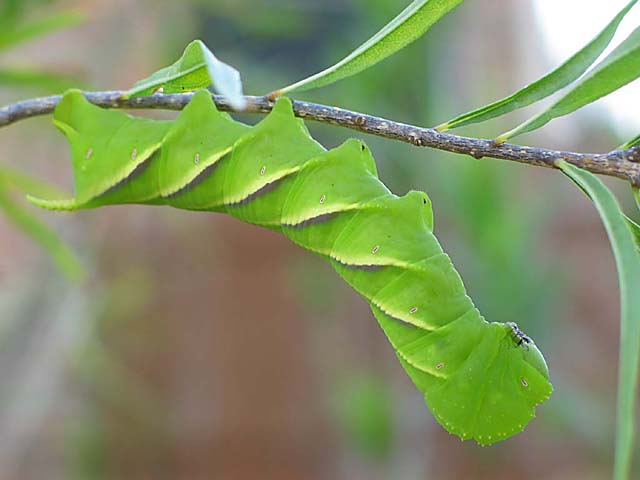
Manduca rustica, Collin County, Texas, courtesy of Kelly Delany.
|
|
Updated as per James P. Tuttle's The Hawk Moths of North America, July 2010 |

Manduca rustica, Collin County, Texas, courtesy of Kelly Delany.
This page is inspired by and dedicated to Kelly Delany who sent me the Manduca rustica larval image at the top of the page.
Kelly also sent images of live Sphingidae adults: Aellopos titan, Hemaris diffinis, Hyles lineata and Xylophanes tersa from Collin County.
Many thanks to Virginia Dyson of DeSoto, Dallas County, for her images of larva and adult Ceratomia hageni.
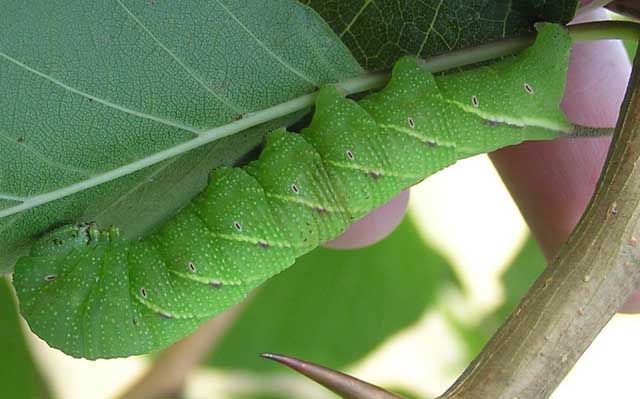
Ceratomia hageni fifth instar on Bois D’arc (Maclura pomifera) tree, DeSoto, Dallas County, Texas,
July 8, 2009, courtesy of Virginia Dyson.
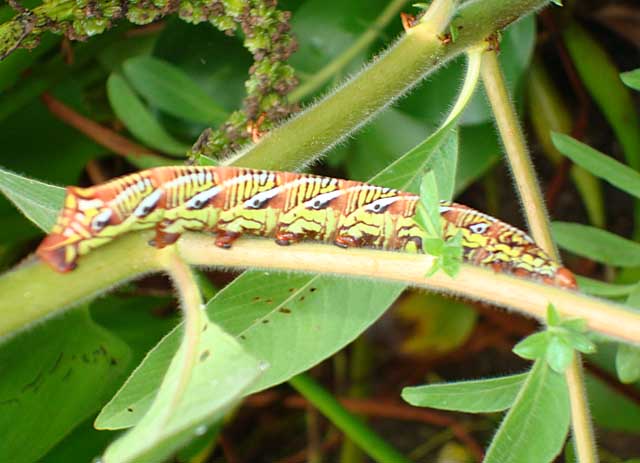
Eumorpha fasciatus, east Texas border, near Shreveport, LA, Gini Huffman.
Seventy-five Sphingidae species are listed for Texas on the U.S.G.S. website (now BAMONA). Not all of the species are reported or anticipated in the northeastern region. It is hoped that this checklist, with the thumbnails and notes, will help you quickly identify the moths you are likely to encounter.
A "USGS" indicates the moth is reported on the USGS website and/or in Lepidoptera of North America, #1. Distribution of Silkmoths (Saturniidae) and Hawkmoths (Sphingidae) of Eastern North America, an excellent little booklet available through Paul Opler.
Paula Copeland sends beautiful images of green and brown forms of Xylophanes tersa from Grayson County, October 4, 2010.
Please help me develop this list with improved, documented accuracy by sending sightings (species, date, location), preferably with an electronic image, via email to Bill Oehlke.
Many thanks to Melanie Schuchart who provides the following image.
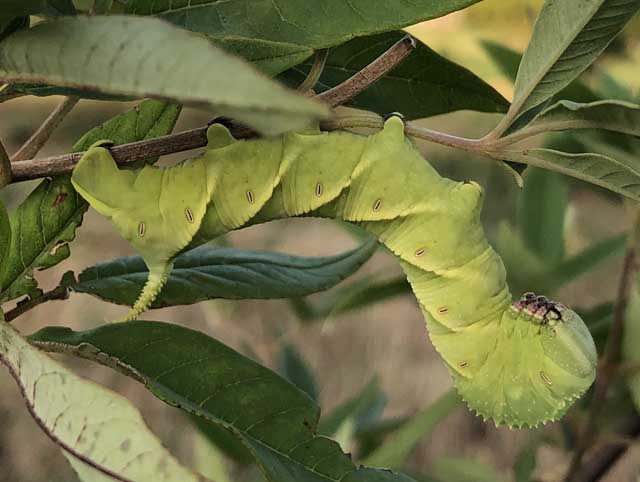
Manduca rustica final instar on Vitex,
Gunter, Grayson County, Texas, July 23, 2019,
courtesy of Melanie Schuchart.
Sphinginae subfamily
|
 |
Agrius cingulata, USGS Pink-spotted hawkmoth. Larvae feed on plants in the Convolvulaceae family, especially Ipomoea batatas (sweet potato) and in the Solanaceae family, especially (Datura) (jimsonweed) and related plants in the Americas. There is also a brown form. |
 | Ceratomia amyntor USGS, the Elm Sphinx or Four-horned SphinxLarvae feed on Elm (Ulmus), birch (Betula), basswood (Tilia), and cherry (Prunus). There are both green and brown forms. The four horns near the head are diagnostic. |
 | Ceratomia catalpae WO/conf., the Catalpa Sphinx
Young caterpillars feed gregariously on Catalpa species
(Catalpa bignoniodes and C. speciosa) in the
Bignoniaceae family, skeletonizing the foliage.
Larvae are mostly white in early instars. |
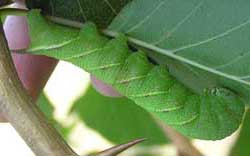 | Ceratomia hageni WO/VD, Hagen's Sphinx or Osage Orange SphinxLarvae feed on osage orange (Maclura pomifera), and they have a granulous appearance with variable amounts of purple along the oblique white stripes. |
 | Ceratomia undulosa USGS, the Waved SphinxFraxinus, Ligustrum, Quercus, Crataegus and Chionanthus virginicus are listed as hosts. In the fifth instar, the spiracular ovals are decidedly red and the anal horn is off-white to pinkish laterally. |
 |
Dolba hyloeus
WO, the Pawpaw Sphinx |

| Isoparce cupressi USGS, Cypress or Baldcypress Sphinx. Larvae feed on needles of baldcypress (Taxodium distichum) at night and pupate in shallow underground burrows where second generation overwinters. |
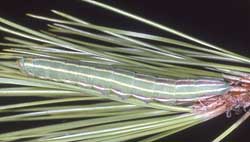 | Lapara phaeobrachycerous USGS, the Gulf Pine SphinxLarvae probably feed upon various pine species, including loblolly pine (Pinus taeda) and longleaf pine (Pinus pinaster). |
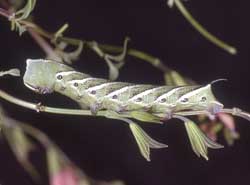 | Lintneria eremitoides USGS. Larval hosts are Sage (Salvia species). The Lintneria larvae will most often be encountered on Lamiaceae: Salvia (Sage), Mentha (Mints), Monarda (Beebalm) and Hyptis (Bushmints); Verbenaceae: Verbena and Lantana camara (shrub verbenas or lantanas). One is even more likely to discover larvae feeding in the evening or after dark. |
Lintneria geminus USGS; unlikely stray, the Gemmed Sphinx MothLarval hosts are probably Lamiaceae: Salvia (Sage), Mentha (Mints), Monarda (Beebalm) and Hyptis (Bushmints); Verbenaceae: Verbena and Lantana camara (shrub verbenas or lantanas). Sorry, no larval image is available at this time. |
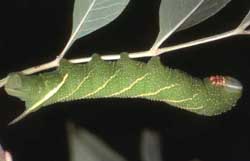 | Manduca jasminearum WO, the Ash SphinxLarvae feed on ash in the Fraxinus genus. Syringa and Ulmus have also been reported. Note the black anal horn. |
 | Manduca quinquemaculatus USGS, the Five-spotted HawkmothThe caterpillars are called Tomato Hornworms and each has a black horn at the end of the abdomen. Larvae feed on potato, tobacco, tomato, and other plants in the nightshade family (Solanaceae). |
 | Manduca rustica USGS/KD/GV/JL/MS, the Rustic Sphinx. Caterpillar (rare black form) has numerous white nodules on top of thorax and seven pairs of oblique, blue-gray stripes along side of the body. Horn is white at base and blue-gray at tip. Many hosts are utilized. |
 | Manduca sexta USGS, the Carolina SphinxTobacco Hornworms, equipped with a red-tipped horn at the end of the abdomen, are true gluttons and feed on tobacco and tomato, and occasionally potato and pepper crops and other plants in the nightshade family (Solanaceae). |
 | Paratrea plebeja USGS, the Plebeian Sphinx. Preferred hosts are common trumpetcreeper (Campsis radicans), Florida yellow-trumpet (Tecoma stans), lilac (Syringa species), and passionflower (Passiflora species).The anal horn is blue, preceded by a yellow dash. |
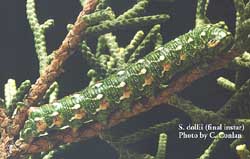 | Sphinx dollii USGS, the Doll's sphinxLarval hosts are Alligator juniper (Juniperus deppeana) and other juniper species. |
 | Amorpha juglandis FS/ML/ USGS, the Walnut Sphinx. Amorpha juglandis larvae feed upon Walnut and butternut (Juglans), hickory (Carya), alder (Alnus), beech (Fagus), hazelnut (Corylus), and hop-hornbeam (Ostrya). |
 | Pachysphinx modesta USGS, the Modest Sphinx or Poplar SphinxLarvae feed on poplars and cottonwood. |
 | Paonias excaecata WO, the Blinded SphinxLarvae accept willows, birches, and cherries. I have also found them in the wild on oak in eastern Canada. generally more eastern species |
 | Paonias myops WO, the Small-eyed SphinxThe larvae depicted is probably third instar. There may be more red spotting on the sides as larvae mature. |
 | Smerinthus jamaicensis USGS, the Twin-spotted SphinxLarvae feed upon many forest trees including birches and cherries, but are expecially fond of poplars and willows. Red markings on sides vary greatly from specimen to specimen. |
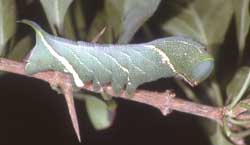 | Aellopos clavipes USGS, the Aellopos Sphinx. Larvae feed on various species of the Rubiaceae (madder) family. Randia rhagocarpa, Randia monantha, Randia aculeata, Guettarda macrosperma and Genipa americana are listed as hosts. Probably only further south. |
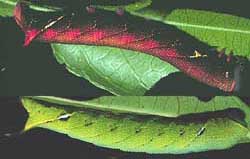 | Aellopos fadus USGS, stray, the Fadus Sphinx.Larvae feed on various species of the Rubiaceae (madder) family, including Genipa americana and Alibertia edulis and Randia species. There are at least two color morphs, a green form and a much darker, reddish-brown form. rare |
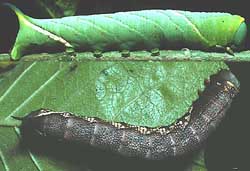 | Aellopos titan USGS/KD, the Titan Sphinx. Larvae feed on seven year apple, Casasia clusiifolia, common buttonbush, Cephalanthus occidentalis, and white indigoberry, Randia mitis. Randia monantha, Randia aculeata, Albizzia adinocephala and Randia grandifolia, all in the madder family (Rubiaceae), also serve as hosts. rare |
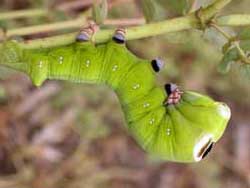 | Erinnyis ello USGS, the Ello Sphinx. Larvae feed on papaya (Carica papaya), Cnidoscolus angustidens, poinsettia (Euphorbia pulcherrima), guava (Psidium species) and saffron plum (Bumelia angustifolia/Bumelia celastrina). Manilkara bahamensis, Willow Bustic (Bumelia salicifolia) and Painted Leaf (Poinsettia heterophylla) are also hosts. Nice socks! Larvae show considerable variation. |
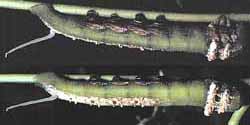 | Erinnyis lassauxii WO, stray, the Dominican Sphinx. Larvae feed on papaya (Carica papaya), Manihot esculenta and various plants (Macroscepis obovata) in the milkweed family. might be present in southern portions of this region. |
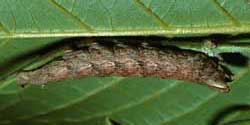 | Erinnyis obscura, the Obscure Sphinx, USGS, stray. Larvae feed on Rauvolfia ligustrina, Rauvolfia tetraphylla, Stemmadenia obovata, Philibertia, Cynanchum, papaya (Carica papaya), Asclepiadaceae, Blepharodon mucronatum, White vine (Sarcostemma clausum) and Morrenia odorata. rare |
 | Hemaris thysbe WO, the Hummingbird ClearwingThere is also an orangey-pink prepupal form. The lateral line runs from S1 to the blue horn. Hemaris thysbe larvae feed on viburnum and related plants. generally more eastern species |
 | Hemaris diffinis USGS/ML, Snowberry Clearwing or Bumblebee Moth. Snowberry (Symphoricarpos), honeysuckle (Lonicera), Coralberry, viburnums, Blue Dogbane (Apocynum), dwarf bush honeysuckle (Diervilla lonicera). Horn black, yellow base. |
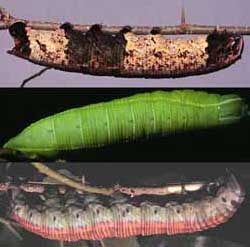 | Pachylia ficus, the Fig Sphinx, USGS, stray. Females feed and lay eggs on fig leaves, especially Strangler Fig (Ficus aurea). Ficus carica, Ficus microcarpa, Ficus religiosa, Ficus pumila, Ficus gamelleira, Ficus prinoides, Ficus pumila and Artocarpus integrifolia are also listed as hosts. The extreme variability of larvae is shown to the left.The few images that have been sent to me for identification help are usually as per the upper image. |
 | Eumorpha achemon USGS, the Achemon Sphinx. Larvae feed upon Grape (Vitis), Virginia Creeper (Parthenocissus quinquefolia) and other vines and ivies (Ampelopsis).Larvae occur in both a light (green) form and a darker (tan/brown) form. Note six "segmented" oblique lines. |
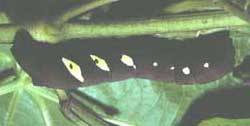 | Eumorpha anchemolus USGS, the Achemon SphinxCissus erosa and Vitis are reported hosts in Brazil. This one is not likely to be seen in Texas. There is also a green form. rare stray |
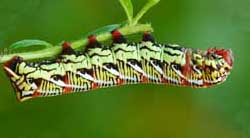 | Eumorpha fasciatus USGS/GH, the Banded Sphinx. Larvae feed upon primrose-willow, Ludwigia (water primrose) and other plants in the evening primrose family. This hornless larva is highly variable. Look for large, dark spiracular circles and a dark line in the center of the back. See image at bottom of this page. |
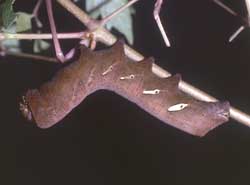 | Eumorpha intermedia WO, the Intermediate Sphinx. Eumorpha intermedia larvae feed upon peppervine, Ampelopsis arborea. Possibly they will also accept grape (Vitis species), but so far no records of that host have been reported to my knowledge. They like to remain well hidden within tangle of vines and probably feed mostly at night. |
 | Eumorpha pandorus USGS, the Pandorus Sphinx. If you have Grape or Virginia Creeper nearby, then you might encounter this species.Note the five large white ovals. There are orangey-brown and green forms also. generally more eastern species |
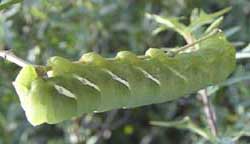 | Eumorpha vitis USGS/Amy Smith/ML, the Vine Sphinx. Eumorpha vitis vitis larvae feed upon grape foliage (Vitis) and other vines (Cissus): Cissus pseudosicyoides and Cissus rhombifolia and Cissus sicycoides. I suspect there would be a brown form. Note five, smooth, narrow, oblique white lines. |
 | Amphion floridensis USGS, the Nessus SphinixIn additon to Virginia creeper larvae accept Grape (Vitis), ampelopsis (Ampelopsis), and cayenne pepper (Capsicum). Larvae are green until the final instar. |
 | Darapsa choerilus USGS, the Azalea SphinxLarvae feed on Azalea and Viburnum and progress very rapidly. The larva to the left on Viburnum cassinoides is getting ready to pupate. Color change from green to light burgundy-brown indicates pupation is imminent. |
 |
Darapsa myron USGS, the Virginia Creeper Sphinx or the Grapevine Sphinx |
 | Darapsa versicolor WO, the Hydrangea Sphinx: Larvae turn deep chocolate brown just prior to pupation, and "horn" on the tail also turns downward as pupation draws near. Darapsa versicolor larvae feed on Smooth hydrangea (Hydrangea arborescens), buttonbush (Cephalanthus occidentalis), and waterwillow (Decodon verticillatus). |
 | Deidamia inscriptum WO?, the Lettered Sphinx. Grape (Vitis), ampelopsis (Ampelopsis), and Virginia creeper (Parthenocissus) all serve as larval hosts.The alternating yellow and greyish-green rings across the back distinguish this larva. |
 | Hyles lineata USGS/KD, the White-lined Sphinx. Larvae are highly varied and feed on a great diversity of plants including willow weed (Epilobium), four o'clock (Mirabilis), apple (Malus), evening primrose (Oenothera), elm (Ulmus), grape (Vitis), tomato (Lycopersicon), purslane (Portulaca), and Fuschia. All larvae seem, however, to have the red/black swellings split by dorso-lateral lines. |
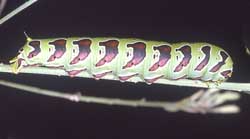 | Proserpinus guarae USGS, the Proud SphinxLarvae feed on (Onagraceae) including evening primrose (Oenothera), gaura (Gaura), and willow weed (Epilobium). rare |
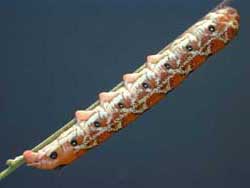 | Proserpinus juanita USGS, the Juanita SphinxLarvae feed on (Onagraceae) including evening primrose (Oenothera), gaura (Gaura), and willow weed (Epilobium). rare |
 | Sphecodina abbottii WO, the Abbott's SphinxLarvae feed at night on grape (Vitis) and ampelopsis (Ampelopsis) and hide on the bark of their host plants during the day. Virginia creeper would also be a suitable host. There is also a dark form without the green patches. Note the "raised eye", replacing the anal horn. generally more eastern species |
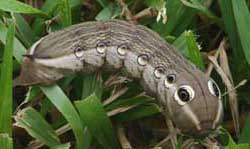 | Xylophanes tersa USGS/KD/SS/PC/LO, the Tersa Sphinx. Larvae also feed on Borreria, Catalpa and Manettia spp. and Smooth buttonplant (Spermacoce glabra) and starclusters (Pentas species). They are also recorded on joe-pie weed and Hamelia patens and on Hedoydis nigricans. The green form may be more common. |
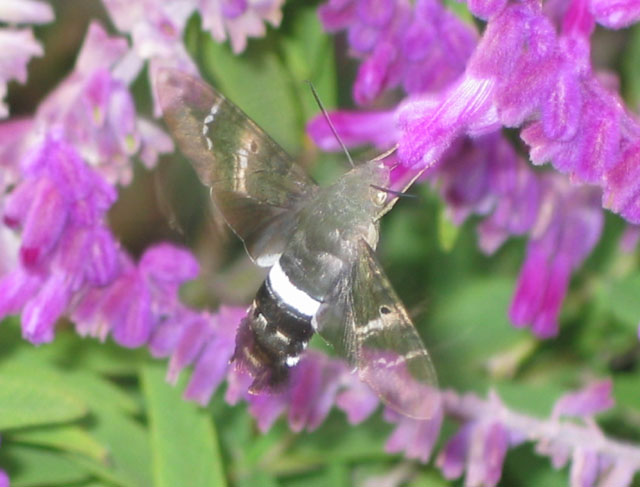
Aellopos titan, nectaring at Mexican Bush Sage, Collin County,
Texas,
5:00pm, October 31, courtesy of Kelly Delany.
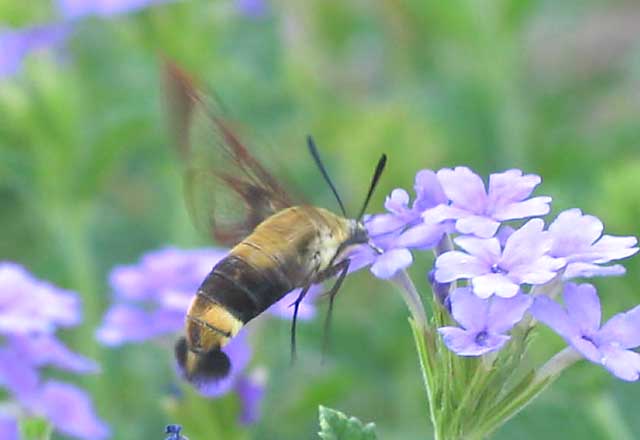
Hemaris diffinis, nectaring, Collin County, Texas, courtesy of Kelly Delany.
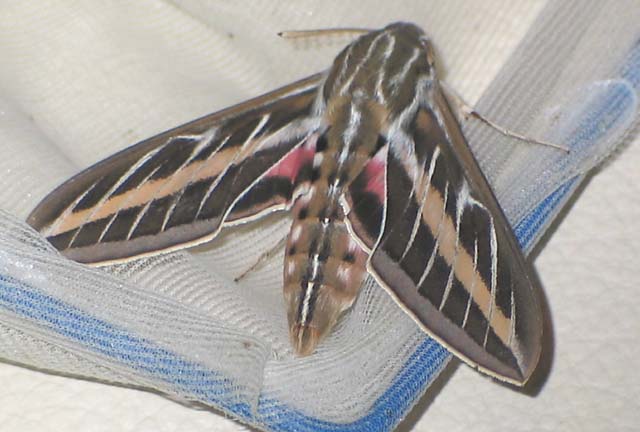
Hyles lineata, Collin County, Texas, courtesy of Kelly Delany.
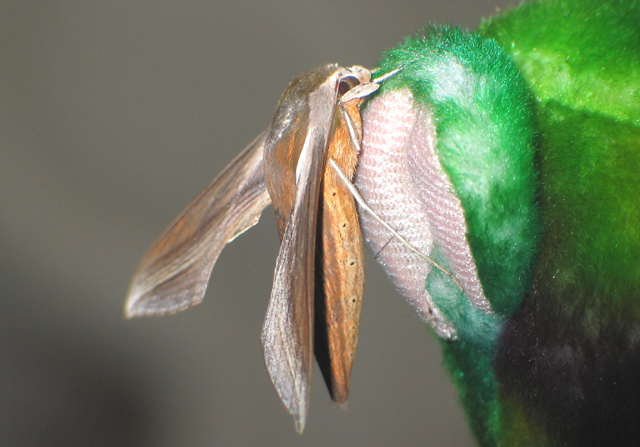
Xylophanes tersa, at rest, Collin County, Texas, courtesy of Kelly Delany.
Enjoy some of nature's wonderments, giant silk moth cocoons. These cocoons are for sale winter and fall. Beautiful Saturniidae moths will emerge the following spring and summer. Read Actias luna rearing article. Additional online help available.
Eggs of many North American species are offered during the spring and summer. Occasionally summer Actias luna and summer Antheraea polyphemus cocoons are available. Shipping to US destinations is done from with in the US.
Use your browser "Back" button to return to the previous page.
This page is brought to you by Bill Oehlke and the WLSS. Pages are on space rented from Bizland. If you would like to become a "Patron of the Sphingidae Site", contact Bill.
Please send sightings/images to Bill. I will do my best to respond to requests for identification help.
 Show appreciation for this site by clicking on flashing butterfly to the left. The link will take you to a page with links to many insect sites. |